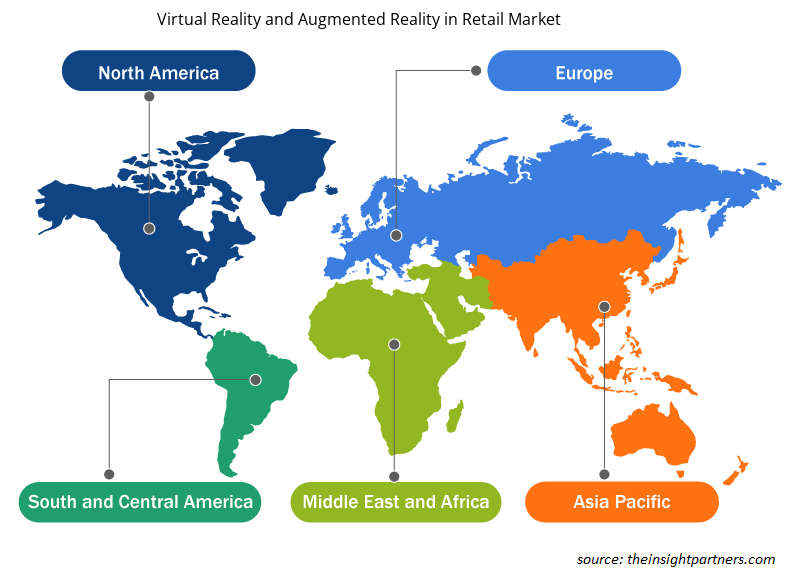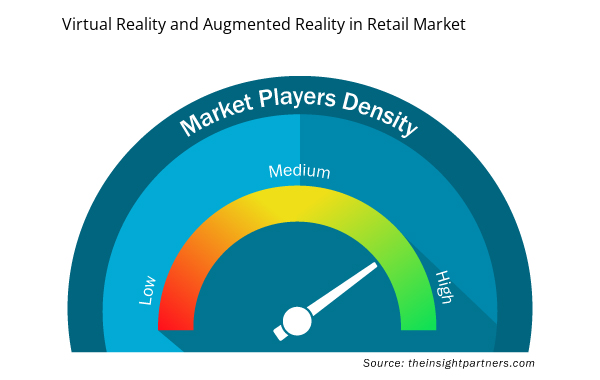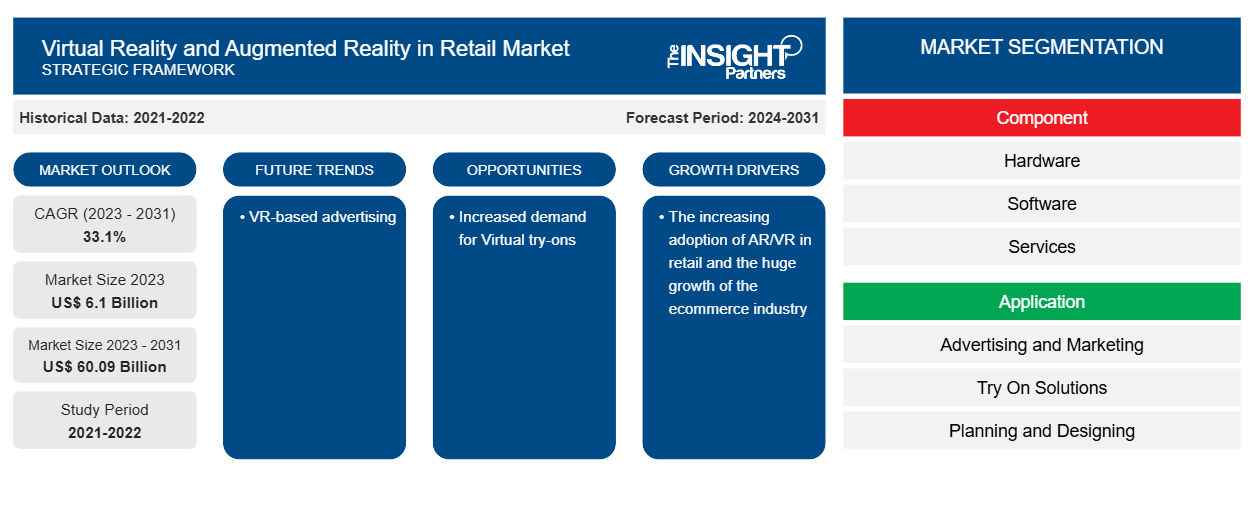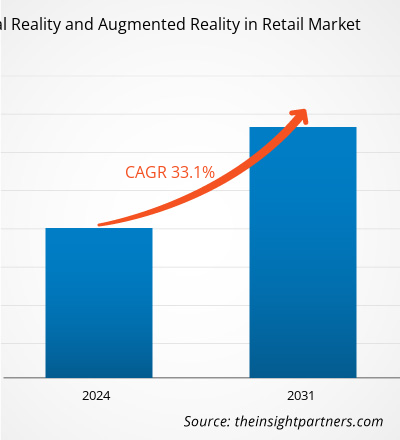من المتوقع أن يصل حجم الواقع الافتراضي والواقع المعزز في قطاع التجزئة إلى 60.09 مليار دولار أمريكي بحلول عام 2031 من 6.1 مليار دولار أمريكي في عام 2023. ومن المتوقع أن يسجل الواقع الافتراضي والواقع المعزز في سوق التجزئة معدل نمو سنوي مركب بنسبة 33.1٪ خلال الفترة 2023-2031. ومن المرجح أن يظل الإعلان القائم على الواقع الافتراضي اتجاهًا رئيسيًا في السوق.
تحليل سوق الواقع الافتراضي والواقع المعزز في تجارة التجزئة
تتضمن الواقع الافتراضي والواقع المعزز في تجارة التجزئة آفاق نمو بسبب اتجاهات السوق الحالية وتأثيرها المتوقع خلال فترة التنبؤ. ينمو الواقع الافتراضي والواقع المعزز في تجارة التجزئة بسبب عوامل مثل التبني المتزايد للواقع المعزز/الواقع الافتراضي في تجارة التجزئة والنمو الهائل لصناعة التجارة الإلكترونية. الطلب المتزايد على التجارب الافتراضية لتوفير فرص مربحة للواقع الافتراضي والواقع المعزز في تجارة التجزئة.
نظرة عامة على سوق الواقع الافتراضي والواقع المعزز في قطاع التجزئة
الواقع الافتراضي والواقع المعزز يغيران مشهد البيع بالتجزئة من خلال تقديم تجارب تسوق غامرة وتفاعلية. يخلق الواقع الافتراضي بيئة رقمية بالكامل حيث يمكن للعملاء استكشاف المتاجر الافتراضية وتصور المنتجات بتقنية ثلاثية الأبعاد وحتى تجربة الملابس افتراضيًا. من ناحية أخرى، يقوم الواقع المعزز بتغطية المعلومات الرقمية على العالم الحقيقي، مما يسمح للمتسوقين برؤية كيف قد يبدو الأثاث في منازلهم أو كيف سيبدو المكياج على وجوههم باستخدام تطبيقات الهواتف الذكية أو المرايا الذكية. تمكن كل من هذه التقنيات تجار التجزئة من سد الفجوة بين التسوق عبر الإنترنت والتسوق داخل المتجر، وتعزيز تصور المنتجات، والحد من الإرجاع، وخلق تجارب جذابة للعلامة التجارية يمكن أن تدفع مشاركة العملاء والمبيعات.
قم بتخصيص هذا التقرير ليناسب متطلباتك
ستحصل على تخصيص لأي تقرير - مجانًا - بما في ذلك أجزاء من هذا التقرير، أو تحليل على مستوى الدولة، وحزمة بيانات Excel، بالإضافة إلى الاستفادة من العروض والخصومات الرائعة للشركات الناشئة والجامعات
- احصل على أهم اتجاهات السوق الرئيسية لهذا التقرير.ستتضمن هذه العينة المجانية تحليلاً للبيانات، بدءًا من اتجاهات السوق وحتى التقديرات والتوقعات.
الواقع الافتراضي والواقع المعزز في سوق التجزئة: العوامل المحركة والفرص
زيادة استخدام الواقع المعزز والافتراضي في قطاع التجزئة لصالح السوق
إن أحد القطاعات الرئيسية التي تأثرت بالعصر الرقمي هو قطاع التجزئة. حيث تستثمر أكبر شركات التجزئة، بما في ذلك وول مارت وعلي بابا وأمازون، بنشاط في تقنيات التجزئة المتطورة من أجل تقديم خدمات أكثر فردية وتفاعلية لعملائها. وتتمثل المكونات الأساسية الثلاثة لتجارة التجزئة الذكية في زيادة الراحة والتخصيص والتخصيص. وتزداد شعبية الحلول المبتكرة مثل التطبيقات التي تعمل بتقنية الواقع المعزز والواقع الافتراضي. وقد بدأت العديد من شركات التجزئة في تبني تقنية الواقع المعزز والواقع الافتراضي بعد شركات التجزئة العملاقة مثل واي فير ولويز وإيكيا. على سبيل المثال، من المتوقع أن يستخدم أكثر من مليار شخص منتجات الواقع المعزز. والرقم مذهل. حيث يسهل الواقع الافتراضي والمعزز على العملاء تحديد الأشياء وتجربتها قبل الشراء. وسوف يصبح التنقل في مراكز التسوق الضخمة أسهل باستخدام الواقع المعزز.
زيادة الطلب على التجارب الافتراضية
إن الطلب المتزايد على التجارب الافتراضية يقدم فرصًا كبيرة لنمو سوق البيع بالتجزئة في مجال الواقع الافتراضي والواقع المعزز. من خلال السماح للعملاء بتصور المنتجات بدقة أكبر قبل الشراء، يمكن للتجارب الافتراضية أن تقلل بشكل كبير من معدلات الإرجاع. وهذا يوفر على تجار التجزئة المال في الشحن وإعادة التخزين، مما يحسن الربحية. وعلاوة على ذلك، مع اكتساب العملاء الثقة في مشترياتهم عبر الإنترنت من خلال التجارب الافتراضية، فإنهم أكثر عرضة لشراء العناصر دون رؤيتها شخصيًا أولاً. يمكن أن يعزز هذا مبيعات التجارة الإلكترونية، وخاصة في فئات مثل الملابس ومستحضرات التجميل . تقدم التجارب الافتراضية تجربة تسوق تفاعلية جديدة يمكن أن تزيد من تفاعل العملاء ورضاهم. وهذا يمكن أن يؤدي إلى تحسين ولاء العلامة التجارية وعمليات الشراء المتكررة.
تقرير تحليلي لتجزئة سوق الواقع الافتراضي والواقع المعزز في قطاع التجزئة
القطاعات الرئيسية التي ساهمت في اشتقاق الواقع الافتراضي والواقع المعزز في تحليل سوق التجزئة هي المكون والتطبيق ونوع التجزئة
- بناءً على المكونات، يتم تقسيم الواقع الافتراضي والواقع المعزز في سوق التجزئة إلى أجهزة وبرامج وخدمات. ومن المتوقع أن يحظى قطاع الأجهزة بحصة سوقية كبيرة في عام 2023.
- من حيث التطبيق، يتم تقسيم السوق إلى الإعلان والتسويق، وحلول التجربة، والتخطيط والتصميم، وغيرها. احتل قطاع الإعلان والتسويق الحصة الأكبر في السوق في عام 2023.
- من حيث نوع التجزئة، يتم تقسيم السوق إلى المجوهرات والملابس ومستحضرات التجميل والأثاث وغيرها). احتل قطاع الملابس أكبر حصة في السوق في عام 2023.
تحليل حصة الواقع الافتراضي والواقع المعزز في سوق التجزئة حسب المنطقة الجغرافية
ينقسم النطاق الجغرافي لتقرير سوق الواقع الافتراضي والواقع المعزز في قطاع التجزئة بشكل أساسي إلى خمس مناطق: أمريكا الشمالية، ومنطقة آسيا والمحيط الهادئ، وأوروبا، والشرق الأوسط وأفريقيا، وأمريكا الجنوبية والوسطى.
يكتسب استخدام الواقع المعزز والواقع الافتراضي في تجارة التجزئة في منطقة آسيا والمحيط الهادئ زخمًا متزايدًا. يتم استخدام هذه التقنيات بشكل متزايد بطرق مختلفة لتحسين تجربة البيع بالتجزئة ودفع مشاركة العملاء. تتمتع هذه التقنيات بإمكانية تحسين تجربة البيع بالتجزئة ودفع مشاركة العملاء وتوفير فرص جديدة للتسويق والتدريب والتعليم في الصناعة.
الواقع الافتراضي والواقع المعزز في سوق التجزئة: رؤى إقليمية
لقد قام المحللون في Insight Partners بشرح الاتجاهات والعوامل الإقليمية المؤثرة على سوق الواقع الافتراضي والواقع المعزز في البيع بالتجزئة طوال فترة التوقعات بشكل شامل. يناقش هذا القسم أيضًا قطاعات ومناطق سوق الواقع الافتراضي والواقع المعزز في البيع بالتجزئة عبر أمريكا الشمالية وأوروبا ومنطقة آسيا والمحيط الهادئ والشرق الأوسط وأفريقيا وأمريكا الجنوبية والوسطى.

- احصل على البيانات الإقليمية المحددة للواقع الافتراضي والواقع المعزز في سوق التجزئة
نطاق تقرير سوق الواقع الافتراضي والواقع المعزز في قطاع التجزئة
| سمة التقرير | تفاصيل |
|---|---|
| حجم السوق في عام 2023 | 6.1 مليار دولار أمريكي |
| حجم السوق بحلول عام 2031 | 60.09 مليار دولار أمريكي |
| معدل النمو السنوي المركب العالمي (2023 - 2031) | 33.1% |
| البيانات التاريخية | 2021-2022 |
| فترة التنبؤ | 2024-2031 |
| القطاعات المغطاة | حسب المكون
|
| المناطق والدول المغطاة | أمريكا الشمالية
|
| قادة السوق وملفات تعريف الشركات الرئيسية |
|
الواقع الافتراضي والواقع المعزز في كثافة اللاعبين في سوق التجزئة: فهم تأثيره على ديناميكيات الأعمال
يشهد سوق الواقع الافتراضي والواقع المعزز في تجارة التجزئة نموًا سريعًا، مدفوعًا بالطلب المتزايد من المستخدم النهائي بسبب عوامل مثل تفضيلات المستهلكين المتطورة والتقدم التكنولوجي والوعي المتزايد بفوائد المنتج. ومع ارتفاع الطلب، تعمل الشركات على توسيع عروضها والابتكار لتلبية احتياجات المستهلكين والاستفادة من الاتجاهات الناشئة، مما يؤدي إلى زيادة نمو السوق.
تشير كثافة اللاعبين في السوق إلى توزيع الشركات أو المؤسسات العاملة في سوق أو صناعة معينة. وهي تشير إلى عدد المنافسين (اللاعبين في السوق) الموجودين في مساحة سوق معينة نسبة إلى حجمها أو قيمتها السوقية الإجمالية.
الشركات الرئيسية العاملة في سوق الواقع الافتراضي والواقع المعزز في مجال البيع بالتجزئة هي:
- شركة إبسون أمريكا
- ماركسنت
- شركة جوجل المحدودة
- إنفوسيس المحدودة
- شركة إنتل
- شركة مايكروسوفت
إخلاء المسؤولية : الشركات المذكورة أعلاه ليست مرتبة بأي ترتيب معين.

- احصل على نظرة عامة على اللاعبين الرئيسيين في سوق الواقع الافتراضي والواقع المعزز في البيع بالتجزئة
الواقع الافتراضي والواقع المعزز في سوق التجزئة الأخبار والتطورات الأخيرة
يتم تقييم الواقع الافتراضي والواقع المعزز في سوق التجزئة من خلال جمع البيانات النوعية والكمية بعد البحث الأولي والثانوي، والذي يتضمن منشورات الشركات المهمة وبيانات الجمعيات وقواعد البيانات. فيما يلي بعض التطورات في الواقع الافتراضي والواقع المعزز في سوق التجزئة:
- أطلقت شركة أبل أول سماعة واقع مختلط لها، Vision Pro، مع 600 تطبيق ولعبة جديدة. ومن بين هذه التطبيقات والألعاب، كانت هناك محاولات لدخول الواقع المعزز والواقع الافتراضي من قبل كبار تجار التجزئة، مستفيدين من القدرة على تقديم رحلات تجارة إلكترونية أكثر تفاعلية للمستهلكين. يقدم تطبيق Vision Pro لمستخدمي السماعة تجربة تسوق ثلاثية الأبعاد، مما يمكنهم من تصفح المنتجات وتجميع الملابس. بالإضافة إلى ذلك، يتيح دمج ميزة Apple SharePlay لمكالمات الفيديو عبر FaceTime لمتاجر التجزئة تقديم المشورة في الوقت الفعلي من المصممين في هذه البيئة الواقعية. (المصدر: Apple، بيان صحفي، فبراير 2024)
- تقدم Zero10 حلولاً رقمية من خلال مرايا الواقع المعزز التي يتم استخدامها في المتاجر والعروض داخل النوافذ لعلامات تجارية مثل Tommy Hilfiger وCoach. كما تستخدم Tommy Hilfiger مرايا الواقع المعزز من شركة Zero10 للتكنولوجيا في أوروبا كجزء من حملتها مع Shawn Mendes وللترويج لإطلاقها الأخير للسترات المنفوخة. وفي الوقت نفسه، تستخدم Coach مرآة الواقع المعزز من Zero10 وواجهة متجر الواقع المعزز للدعاية لحملات حقيبة Tabby وموسم العطلات (المصدر: Zero10، بيان صحفي، أبريل 2024)
تقرير تغطية سوق الواقع الافتراضي والواقع المعزز في قطاع التجزئة والمنتجات النهائية
يقدم تقرير "حجم سوق الواقع الافتراضي والواقع المعزز في قطاع التجزئة والتوقعات (2021-2031)" تحليلاً مفصلاً للسوق يغطي المجالات التالية:
- حجم سوق الواقع الافتراضي والواقع المعزز في البيع بالتجزئة والتوقعات على المستويات العالمية والإقليمية والوطنية لجميع قطاعات السوق الرئيسية التي يغطيها النطاق
- الواقع الافتراضي والواقع المعزز في اتجاهات سوق التجزئة، فضلاً عن ديناميكيات السوق مثل المحركات والقيود والفرص الرئيسية
- تحليل مفصل لقوى PEST/Porter الخمس وSWOT
- تحليل سوق الواقع الافتراضي والواقع المعزز في تجارة التجزئة يغطي اتجاهات السوق الرئيسية والإطار العالمي والإقليمي والجهات الفاعلة الرئيسية واللوائح والتطورات الأخيرة في السوق
- تحليل المشهد الصناعي والمنافسة الذي يغطي تركيز السوق، وتحليل خريطة الحرارة، واللاعبين البارزين، والتطورات الأخيرة للواقع الافتراضي والواقع المعزز في سوق التجزئة
- ملفات تعريف الشركة التفصيلية
- التحليل التاريخي (سنتان)، السنة الأساسية، التوقعات (7 سنوات) مع معدل النمو السنوي المركب
- تحليل PEST و SWOT
- حجم السوق والقيمة / الحجم - عالميًا وإقليميًا وقطريًا
- الصناعة والمنافسة
- مجموعة بيانات Excel



Report Coverage
Revenue forecast, Company Analysis, Industry landscape, Growth factors, and Trends

Segment Covered
This text is related
to segments covered.

Regional Scope
North America, Europe, Asia Pacific, Middle East & Africa, South & Central America

Country Scope
This text is related
to country scope.
الأسئلة الشائعة
North America is expected to dominate the virtual reality and augmented reality in the retail market with the highest market share in 2023.
The virtual reality and augmented reality in retail market size is projected to reach US$ 60.09 billion by 2031.
The leading players operating in the virtual reality and augmented reality in the retail market are Epson America, Inc.; Marxent; Google LLC; Infosys Ltd; Intel Corporation; Microsoft Corporation; PTC Inc.; Qualcomm Technologies, Inc.; Retail VR
VR-based advertising is anticipated to play a significant role in the global virtual reality and augmented reality retail market in the coming years.
Increasing adoption of AR/VR in retail and the huge growth of the ecommerce industry are the major factors driving virtual reality and augmented reality in the retail market.
The global virtual reality and augmented reality in the retail market is expected to grow at a CAGR of 33.1% during the forecast period 2024 - 2031.
Trends and growth analysis reports related to Technology, Media and Telecommunications : READ MORE..
The Insight Partners performs research in 4 major stages: Data Collection & Secondary Research, Primary Research, Data Analysis and Data Triangulation & Final Review.
- Data Collection and Secondary Research:
As a market research and consulting firm operating from a decade, we have published and advised several client across the globe. First step for any study will start with an assessment of currently available data and insights from existing reports. Further, historical and current market information is collected from Investor Presentations, Annual Reports, SEC Filings, etc., and other information related to company’s performance and market positioning are gathered from Paid Databases (Factiva, Hoovers, and Reuters) and various other publications available in public domain.
Several associations trade associates, technical forums, institutes, societies and organization are accessed to gain technical as well as market related insights through their publications such as research papers, blogs and press releases related to the studies are referred to get cues about the market. Further, white papers, journals, magazines, and other news articles published in last 3 years are scrutinized and analyzed to understand the current market trends.
- Primary Research:
The primarily interview analysis comprise of data obtained from industry participants interview and answers to survey questions gathered by in-house primary team.
For primary research, interviews are conducted with industry experts/CEOs/Marketing Managers/VPs/Subject Matter Experts from both demand and supply side to get a 360-degree view of the market. The primary team conducts several interviews based on the complexity of the markets to understand the various market trends and dynamics which makes research more credible and precise.
A typical research interview fulfils the following functions:
- Provides first-hand information on the market size, market trends, growth trends, competitive landscape, and outlook
- Validates and strengthens in-house secondary research findings
- Develops the analysis team’s expertise and market understanding
Primary research involves email interactions and telephone interviews for each market, category, segment, and sub-segment across geographies. The participants who typically take part in such a process include, but are not limited to:
- Industry participants: VPs, business development managers, market intelligence managers and national sales managers
- Outside experts: Valuation experts, research analysts and key opinion leaders specializing in the electronics and semiconductor industry.
Below is the breakup of our primary respondents by company, designation, and region:

Once we receive the confirmation from primary research sources or primary respondents, we finalize the base year market estimation and forecast the data as per the macroeconomic and microeconomic factors assessed during data collection.
- Data Analysis:
Once data is validated through both secondary as well as primary respondents, we finalize the market estimations by hypothesis formulation and factor analysis at regional and country level.
- Macro-Economic Factor Analysis:
We analyse macroeconomic indicators such the gross domestic product (GDP), increase in the demand for goods and services across industries, technological advancement, regional economic growth, governmental policies, the influence of COVID-19, PEST analysis, and other aspects. This analysis aids in setting benchmarks for various nations/regions and approximating market splits. Additionally, the general trend of the aforementioned components aid in determining the market's development possibilities.
- Country Level Data:
Various factors that are especially aligned to the country are taken into account to determine the market size for a certain area and country, including the presence of vendors, such as headquarters and offices, the country's GDP, demand patterns, and industry growth. To comprehend the market dynamics for the nation, a number of growth variables, inhibitors, application areas, and current market trends are researched. The aforementioned elements aid in determining the country's overall market's growth potential.
- Company Profile:
The “Table of Contents” is formulated by listing and analyzing more than 25 - 30 companies operating in the market ecosystem across geographies. However, we profile only 10 companies as a standard practice in our syndicate reports. These 10 companies comprise leading, emerging, and regional players. Nonetheless, our analysis is not restricted to the 10 listed companies, we also analyze other companies present in the market to develop a holistic view and understand the prevailing trends. The “Company Profiles” section in the report covers key facts, business description, products & services, financial information, SWOT analysis, and key developments. The financial information presented is extracted from the annual reports and official documents of the publicly listed companies. Upon collecting the information for the sections of respective companies, we verify them via various primary sources and then compile the data in respective company profiles. The company level information helps us in deriving the base number as well as in forecasting the market size.
- Developing Base Number:
Aggregation of sales statistics (2020-2022) and macro-economic factor, and other secondary and primary research insights are utilized to arrive at base number and related market shares for 2022. The data gaps are identified in this step and relevant market data is analyzed, collected from paid primary interviews or databases. On finalizing the base year market size, forecasts are developed on the basis of macro-economic, industry and market growth factors and company level analysis.
- Data Triangulation and Final Review:
The market findings and base year market size calculations are validated from supply as well as demand side. Demand side validations are based on macro-economic factor analysis and benchmarks for respective regions and countries. In case of supply side validations, revenues of major companies are estimated (in case not available) based on industry benchmark, approximate number of employees, product portfolio, and primary interviews revenues are gathered. Further revenue from target product/service segment is assessed to avoid overshooting of market statistics. In case of heavy deviations between supply and demand side values, all thes steps are repeated to achieve synchronization.
We follow an iterative model, wherein we share our research findings with Subject Matter Experts (SME’s) and Key Opinion Leaders (KOLs) until consensus view of the market is not formulated – this model negates any drastic deviation in the opinions of experts. Only validated and universally acceptable research findings are quoted in our reports.
We have important check points that we use to validate our research findings – which we call – data triangulation, where we validate the information, we generate from secondary sources with primary interviews and then we re-validate with our internal data bases and Subject matter experts. This comprehensive model enables us to deliver high quality, reliable data in shortest possible time.


 احصل على عينة مجانية لهذا التقرير
احصل على عينة مجانية لهذا التقرير